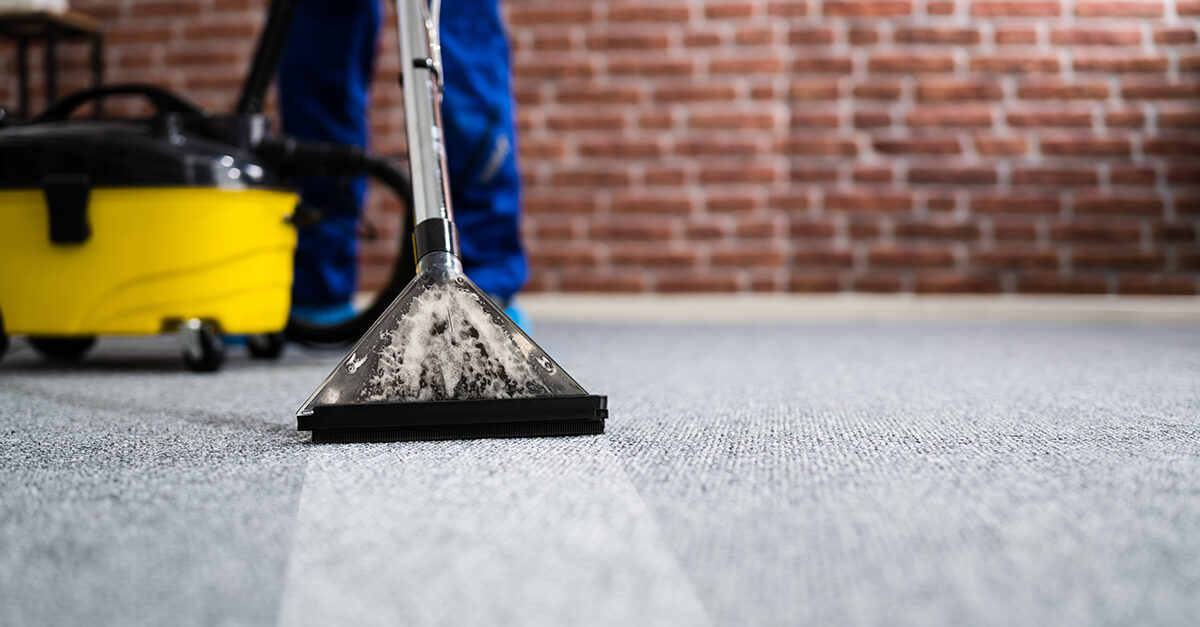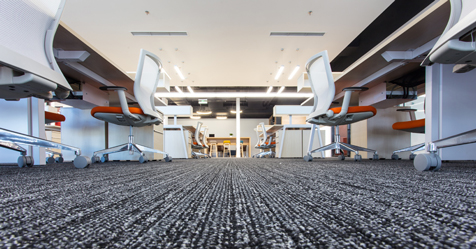When you see or hear “system” or “program,” you probably think of something complete, like an exercise program that encompasses everything you need to become or stay fit. Think: diet, scheduled exercise, professional training, evaluation, and feedback. A carpet care program should be thought of in the same way. Think: preventive, interim, and deep cleaning processes. Like a puzzle, each piece is needed to complete your floor maintenance program.
In the past, we thought the only way to really clean carpet was with hot water extraction (water rinse extraction) by using either a portable or truck-mounted extractor. Over time we figured out that you can maintain a level of clean by not waiting for the soil to build up to a point at which it becomes visible (or cause permanent damage to the fibers). Rather, we can remove lesser amounts of soil more often via interim maintenance processes. After all, it is far easier to keep up, rather than to catch up.
These interim maintenance processes are effective, and if combined with a proper vacuuming program, can maintain a carpet’s appearance for a long time.
However, a one-size-fits all-approach doesn’t fit all cleaning systems. That is why it is essential not to forget a deep cleaning process such as water rinse extraction in the regimen.
The ANSI/IICRC S100 – 2021 Standard for Professional Cleaning of Textile Floor Coverings (Seventh Edition) states that “maximum soil separation incorporates four elements:
- Chemical activity
- Temperature
- Mechanical action/agitation for proper chemical distribution
- Time for chemicals to function properly.”
When one or more of these four fundamentals is decreased, one or more of the other elements should be increased to achieve optimum soil suspension. The different types of extraction processes address the removal process differently, and can have varying degrees of removal; however, they do remove soil when done correctly.
Extraction methods explained
There are various types of extraction carpet cleaning methods. Here is an introduction to four recommended methods. The ANSI/IICRC S100 – 2021 Standard for Professional Cleaning of Textile Floor Coverings (Seventh Edition) lists the detailed steps for each method.
Water rinse extraction—Water, or a solution of water and chemicals, is injected into the carpet’s nap. The process causes the soil to become suspended in the liquid and then is removed through the lift of a wet vacuum. You can use either hot or cold water in this process.
Encapsulant extraction—This method is a liquid low-moisture encapsulation cleaning system made up of detergents containing crystallizing polymers. These encapsulants can be agitated into the carpet to emulsify the soil in various ways, including a pressure sprayer, a scrubber with an integrated sprayer, or a solution pump.The crystallizing polymers start to work as soon as the encapsulant is applied and exposed to the air. As the solution dries out, the polymers crystalize, surrounding the soil they have captured. The crystals then hold the soil and can be removed by dry vacuuming with standard vacuuming equipment.
Dry foam extraction—An encapsulating detergent is made into foam by using a foam-generating device to add air to the detergent. The dry foam is applied to the carpet and agitated into the fiber with a mechanical device. The foam dissipates and dries. The area is dry vacuumed to remove the encapsulated soil from the carpet.
Dry compound extraction—This is a low/restricted moisture compound cleaning system that works by adsorbing or absorbing the soil in the carpet. Dry compounds are comprised of a granular carrier with detergent and water. The dry compound is applied and agitated into the carpet, usually with a mechanical device, to adsorb soil in the carpet. It must be allowed to completely dry, and then it can be dry vacuumed from the carpet, using standard vacuuming equipment. For this to be effective, all of the granular carrier must be removed from
the carpet.
Areas ripe for deep cleaning extraction
For 99% of facilities out there, some deep cleaning extraction should be involved in the cleaning process. Here are a few main areas in your building that can benefit from extraction.
Walk-off carpet systems—These systems are the first line of defense in the building envelope, taking the brunt of the wear and tear. They need to be vacuumed daily, but more importantly, deep cleaned more frequently. While walk-off carpet is essential at entrances and in vestibules of facilities, it can also be incorporated into the design of the space at transitional areas—such as where a hard kitchen floor meets a soft surface—to prevent soil migration throughout a facility.
The sole purpose of walk-off carpet is to accept soil up to the point of refusal. Even with a good vacuuming program and interim cleaning process in place, soil can migrate into a facility. These systems can become ineffective when overloaded by heavy foot traffic from special events, or the seasonal overuse of ice melt products outside.
High-traffic areas—Frequently used areas of a facility need higher frequencies of both interim maintenance and deep cleaning measures to maintain the highest level of cleanliness and appearance retention. Think of the bottlenecks, pivot points, card swipe doorways, elevators,
and staircases. Other unique areas such as those with constant food and beverage services will typically need a deep cleaning process to clean up large food or beverage spills and trash bag leaks, for example.
Note: Any area in a facility where there is a transition from hard flooring to soft flooring can be prone to easy transfer of soils due to the hard surface’s inability to trap and hold soil. Improper hard floor maintenance can greatly shorten the lifespan and negatively affect the appearance of the adjacent soft surfaces. Inadequate hard floor maintenance processes are often obvious in elevator lobbies and outside of restroom areas that are exposed to quat walk-off or disinfectant cleaner or
deodorizer oversprays.
Workstations—More recently, the “workstation/living area,” as we like to call it, has become very susceptible to heavy soiling exposure. With social distancing in office environments still common, the tendency is for occupants to not move around the space, but rather “live” there each day, causing much greater soiling effects around the workstation (food, outside soils, dander, etc.) that all need to be extracted out of the carpet as well.
Resources for proper extraction equipment selection
Doing things correctly has a lot to do with the equipment you use for the extraction process. The Carpet and Rug Institute (CRI) has Seal of Approval (SOA) programs for not only chemistry, but also for vacuums and extraction equipment. Whether it’s vacuuming of encapsulated, adsorbed/absorbed soil or suspended soil being extracted through water rinse extraction process, these SOA programs can assist you with making choices on equipment efficacy for removal of soil.
A proactive approach pays off
Trying to clean a floor that has been neglected for too long can be costly and ineffective. It also uses manpower, equipment, and resources that strain the budget.
Make sure to include proper extraction in the cleaning process to meet the needs of building environments, occupants, and clients. Reactionary cleaning when carpet appears dirty instead of following a complete proactive floor care program will cost more in the long run and will make it harder to achieve the desired outcomes. Protect your flooring investment by doing floor care the right way.





